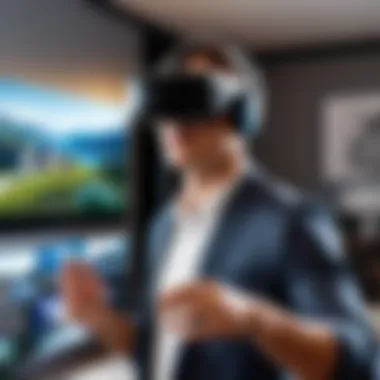Exploring Virtual Land Ownership in Digital Real Estate


Intro
In a world where our daily lives are increasingly intertwined with technology, the notion of owning land in a virtual landscape is no longer a far-fetched dream. As we continue to delve deeper into metaverses and digital realms, the idea of virtual land ownership emerges as both an intriguing concept and a genuine investment opportunity. The implications of this new frontier are vast, echoing across various sectors from social interaction to commerce and even art.
Overview of the Technology
The backbone of virtual land ownership rests on rapidly evolving technologies. Blockchain, the foundation for most digital currencies, also plays a crucial role in the acquisition and trade of virtual real estate. With blockchain's ability to provide an immutable record of ownership, buyers can rest assured their virtual property is uniquely theirs and can't be easily duplicated.
- Key specifications:
- Unique selling points:
- Decentralization ensures that no single entity has total control over the virtual land.
- Smart contracts facilitate transparent transactions, automating the process and reducing the risk of fraud.
- Interoperability across different platforms allows virtual landowners to develop their properties in a variety of metaverses.
- Potential for appreciation in value as digital economies flourish.
- Opportunities for creative expression and business development such as virtual pop-up shops or immersive experiences.
Design and Build Quality
While the term 'virtual land' suggests an ephemeral environment, the design and construction of these spaces are anything but. Various platforms offer diverse tools for creating distinct landscapes, ranging from simple plots to sprawling digital cities.
- Materials used:
- Ergonomics and usability:
- Unlike physical land, the 'materials' in virtual spaces come from graphics and coding, providing flexibility in creation.
- Developers can design everything from lush gardens to futuristic buildings using user-friendly interfaces or complex programming.
- The usability of virtual land interfaces often hinges on the design; they aim to provide an intuitive experience for users whether they are gamers or investors.
- Dynamic navigation, customizable layouts, and accessibility standards play essential roles in how effectively users can engage with their virtual properties.
"As technology pivots toward increasingly immersive experiences, virtual land ownership could redefine our understanding of real estate."
This comprehensive examination of virtual land ownership provides insights that could help tech-savvy individuals navigate the complexities of this emerging digital domain. As we proceed further, some challenges and considerations regarding property rights, digital security, and economic implications warrant thoughtful discussion.
Understanding Virtual Land
Understanding virtual land is essential in grasping the evolving digital landscape. As the boundary between the real and virtual worlds continues to blur, ownership of virtual spaces has become not just a trend but a legitimate field of commerce and social interaction. The immense popularity of the metaverse has given rise to a new class of asset—virtual land. This asset class carries significant implications for both individuals and businesses, as it offers innovative avenues for revenue generation, community building, and even personal expression.
Definition of Virtual Land
Virtual land refers to digital real estate within online environments or platforms, often referred to as metaverses like Decentraland or The Sandbox. Unlike physical land, virtual land does not exist in a tangible form; instead, it exists as a digital representation governed by blockchain technology. Each parcel of virtual land is identifiable through a unique digital token, making it a distinct asset that can be bought, sold, or traded, similar to physical property.
This form of land can be used for various purposes, from hosting social events and businesses to building virtual art galleries or gaming experiences. One vital aspect to note is that ownership of virtual land typically comes with rights to develop and enhance the space according to the owner's vision, creating opportunities for creativity and innovation.
Historical Context
The concept of virtual land ownership has roots that trace back to the early days of the internet. Online spaces began as simple chat rooms or basic websites, but the development of more complex social environments, like Second Life, allowed users to create and trade virtual properties. These early examples laid the groundwork for what we now know as the metaverse, exemplifying how digital interaction paved the way for real estate ownership in virtual realms.
As technology progressed, introducing blockchain systems enabled secure transactions and verifiable ownership. The 2020 pandemic accelerated this shift, leading more users to seek virtual interactions and experiences, which further fueled the demand for virtual land in contemporary platforms.
Relation to Digital Economy
In the current landscape, virtual land ownership is tightly interwoven with the broader digital economy. With increased engagement in the metaverse, various economic activities are emerging, ranging from virtual concerts to immersive shopping experiences. Companies recognize the potential of virtual land as a marketing tool, often investing in these digital spaces to host events or advertise their products.
The virtual real estate market not only reflects individual entrepreneurial endeavors but also highlights shifts in consumer behavior. Younger generations are increasingly looking to spend time and money in virtual spaces, challenging traditional notions about property value and investments. Access to digital ownership also fosters a more decentralized and democratized economy, breaking down geographic and socioeconomic barriers, enabling wider participation in these new markets.
"As we delve deeper into technology, the way we interact with space continues to evolve. Virtual land is not just an asset; it's a paradigm shift in how we understand ownership and presence in a digital future."
The Rise of the Metaverse
The rise of the metaverse marks a transformative chapter in the evolution of virtual land ownership. As digital environments expand and improve, more users are drawn into these immersive worlds where they can own, build, and trade properties just like they would in the physical realm. The importance of understanding the metaverse cannot be overstated for anyone looking to navigate this modern digital landscape. By grasping its nuances, investors and enthusiasts can make informed decisions, participate in unique opportunities, and appreciate the broader implications of virtual land as a new asset class.
Key Characteristics of the Metaverse
At its core, the metaverse is characterized by interactivity and connectivity. Here are a few significant traits:


- Persistence: Unlike traditional video games, the metaverse continues to exist and evolve even when users log off. This aspect encourages a sense of ownership and real investment in digital land.
- Interoperability: Users can find structures and experiences that move between different virtual environments. This fluidity often leads to a more enriched experience and stronger community ties.
- User-Generated Content: A hallmark of the metaverse, the creation of assets by users themselves promotes unprecedented customization. Properties can be built and modified on a scale not possible in real life, empowering creativity in ways that can’t be rivaled.
- Economic Systems: Within the metaverse, virtual economies mirror the real economy. Users can exchange goods and services using cryptocurrency or other digital currencies, adding a layer of complexity.
With such features, the metaverse shifts how we perceive interactions, commerce, and hospitality on digital platforms.
Platforms Facilitating Virtual Land
Several platforms lay the groundwork for virtual land ownership, each offering unique elements:
- Decentraland: This decentralized platform emphasizes community governance, allowing users to vote on changes and policies for the environment. Buying land here equates to owning a piece of a thriving virtual city.
- The Sandbox: This platform is designed for gamers and creators alike. It enables users to create, own, and monetize gaming experiences and assets. The land here can host various experiences, from real estate ventures to social hangouts.
- Somnium Space: A VR-focused platform where users can immerse themselves in the metaverse through virtual reality. This platform has robust tools for land development suitable for commercial and leisure purposes.
These platforms cater to different interests and provide unique experiences, encouraging users to explore virtual properties and consider their investments seriously.
User Engagement and Interaction
Engagement within metaverse platforms goes beyond simple transactions; it cultivates community involvement and social connections. Users participate in events, build friendships, and create meaningful experiences through a variety of interactive features:
- Social Spaces: Many platforms provide areas for users to meet and interact. These can range from informal chat rooms to elaborate festivals where users can join together.
- Collaboration Features: Users across platforms often engage in projects, from hosting concerts to developing urban designs. Engagement promotes not just individual enjoyment but also community growth.
- Augmented Events: Special events, such as art exhibits or political rallies, are becoming increasingly popular, drawing participation from thousands. These events can significantly improve engagement, providing unique shared experiences.
In observing these dynamics, it’s clear that the relationships fostered in the metaverse can have lasting impacts on user retention and platform development.
"The metaverse is not just a trend; it's the evolution of our very interaction with technology and digital spaces, redefining how we engage and invest in our virtual lives.”
In summary, the rise of the metaverse presents a fascinating opportunity for virtual land ownership. As platforms mature and technology advances, the potential for investment and innovation will likely continue to flourish, making it imperative for users to stay abreast of developments.
Ways to Purchase Virtual Land
Buying virtual land is becoming a game changer for many in the tech sphere. The rise of the metaverse has catalyzed a new digital frontier where virtual real estate is as crucial as its physical counterpart. Understanding how to navigate this unique marketplace is vital for anyone considering investment in this nascent realm.
Owning virtual land has many benefits. For one, it provides a stake in digital communities that are growing by leaps and bounds. Aside from the investment aspect, virtual land can serve personal, business, or even entertainment purposes. Still, before diving headfirst into the digital soil, one ought to grasp how and where to make such purchases.
Marketplaces for Virtual Real Estate
Various platforms operate as online marketplaces, facilitating the trade of virtual real estate. These spaces can be likened to bustling bazaars, albeit in a digital setting. Well-known platforms include Decentraland, Sandbox, and Cryptovoxels where users can buy land parcels using cryptocurrency.
Key Features of These Marketplaces:
- User-Friendly Interface: Many of these marketplaces are designed to be intuitive, offering filters and search tools to help users find what they’re after with little fuss.
- Transparent Transactions: They often provide a transparent view of the ownership history and market price trends, which is critical for making informed purchases.
- Community Engagement: These platforms often come with vibrant communities, offering forums, tutorials, and FAQs, making it easier for newcomers to step into the game.
Auction Systems and Pricing Strategies
In the world of virtual land, auction systems hold a unique charm. Not only do they build a sense of urgency, but they also reflect the principle of supply and demand. Many virtual land sales occur via auction, driving prices up when multiple bidders vie for an attractive plot.
Here are some aspects to consider when participating in auctions:
- Time-Bound Bidding: Auctions typically have set time frames, so it's crucial to stay alert. You may find yourself in a bidding war more intense than a championship final!
- Starting Bids and Reserves: Most auctions start with a minimal bid, but an understanding of the reserve price (the minimum a seller will accept) can save you from overcommitting financially.
Many platforms also provide features that allow users to analyze pricing trends based on historical data, letting potential buyers make informed decisions before strapping on their bidding boots.
Payment Methods and Transactions
The method of payment is where things can get a bit complex, particularly for those new to the cryptocurrency world. Virtual land transactions usually require using cryptocurrencies such as Ethereum or specific platform tokens.
Common Payment Methods Include:
- Cryptocurrency Wallets: Before you can close a deal, a well-functioning digital wallet is key. This is how you will store and transact your digital currency.
- Smart Contracts: Most transactions are secured and executed using smart contracts, ensuring that the terms are honored and reducing the risk of fraud.
- Decentralized Exchanges: These allow for peer-to-peer transactions without the need for intermediaries, making purchases less cumbersome.
As with any financial transaction, understanding fees associated with these methods is crucial. Transaction fees, network fees, and gas fees can all add up before you know it.
Investing in virtual land is not just about the real estate itself but also about becoming part of a digital movement that is defining the future.


Navigating the waters of virtual land ownership requires knowledge as well as strategic thinking. The various platforms and transaction systems present both opportunities and challenges. It's an intricate dance of planning, understanding the marketplace, and executing sound financial decisions.
Investment Potential
Understanding the investment potential of virtual land ownership is crucial in today’s digital economy. As the world increasingly transitions into virtual spaces, owning a piece of this digital frontier can be both a novel adventure and a lucrative opportunity. Here, we delve into market trends, risk assessment, and long-term value to paint a clearer picture of this emerging domain.
Market Trends and Analysis
In recent years, the virtual land market has experienced seismic shifts, echoing the fluctuations seen in traditional real estate. Investors are now paying close attention to various platforms like Decentraland or The Sandbox, which allow users to buy, develop, and sell virtual parcels. The surge of interest in blockchain technology and NFTs has also added momentum to this market.
Interestingly, the growth rate of virtual land prices has outpaced some physical real estate sectors, making it a hotbed for speculation. Investors watch trends closely, often referencing data from aggregator sites like NonFungible.com to keep tabs on price movements and overall market sentiment. Furthermore, social events or in-game activities can dramatically increase the value of particular plots, reflecting the highly volatile nature of the market.
Potential buyers should scoot their eyes around not just price tags but also what kind of engagement a piece of virtual land can generate. With a large community engagement, certain regions within these metaverse platforms can becoming significantly more valuable compared to isolated areas.
"Virtual land is not just a plot on a map, it’s an investment in experiences and communities."
Risk Assessment in Virtual Land Investment
Investing in virtual land comes with its own set of challenges. Unlike brick-and-mortar real estate, where one can physically inspect the property and derive a sense of its worth, virtual land requires a different approach.
Key risks include:
- Market Volatility: The prices in the virtual land market can swing wildly, driven by trends, hype, and market manipulation. Keeping an eye on changing buyer preferences can help mitigate risks.
- Platform Dependency: Many virtual lands are tied to specific platforms. Should any one of these platforms falter, the associated virtual properties may fall dramatically in value.
- Regulatory Challenges: As this area remains largely unregulated, the frameworks governing virtual land ownership may evolve, potentially impacting ownership rights and market practices.
Investors should strengthen their research efforts to assess the credibility of the platforms and understand the underlying technology.
Long-Term Value and Returns
While the current landscape for virtual land ownership is undoubtedly dynamic, examining the long-term potential is valuable. Industry experts believe that as AR, VR, and the metaverse grow, so too will the demand for virtual land.
Several factors contribute to its long-term worth:
- Scarcity: Just like physical land, digital land areas can be limited. The notion of scarcity often brings higher values over time.
- Development Opportunities: Owning land in a digital environment allows for endless creative pursuits. Whether it's hosting events or creating interactive experiences, these activities can generate income, thus enhancing the value of the property.
- Community Building: Properties situated in vibrant, user-friendly environments tend to see increased footfall, contributing to potential revenue.
Social and Ethical Implications
The landscape of virtual land ownership has grown immensely, intertwining with various social and ethical considerations. As individuals and businesses invest in this digital terrain, it’s critical to understand its broader impact on society. Social implications can encompass accessibility issues, the digital divide, and how owned virtual spaces influence real-world Dynamics. Ethical considerations involve evaluating ownership rights, governance, and accountability in virtual environments.
Digital Divide and Accessibility
The digital divide is one of the most pressing issues in the realm of online real estate. As virtual land becomes a sought-after commodity, not everyone possesses equal access or ability to engage in this market. This disparity often falls along socioeconomic lines and geographical locations. Those with advanced tech abilities, capital, and resources may dominate the virtual land arena, leaving others behind.
Without proper initiatives and thoughtful design, such imbalances could lead to exclusive digital spaces where only the affluent thrive while underrepresented communities are effectively locked out. It is essential to recognize how the growth of virtual environments can perpetuate existing inequalities. People without access to high-speed internet or sophisticated devices might find themselves excluded from exploring opportunities in the metaverse. Furthermore, digital literacy plays a significant role; a domain dominated by tech-savvy individuals can alienate those who are less familiar with the latest digital tools.
In a rapidly evolving digital world, initiatives promoting inclusivity are vital. This may include creating affordable access points like community centers that can step in to bridge this divide, or even finding ways to incentivize the development of user-friendly platforms that are easier for the less tech-inclined populace to navigate.
Regulation and Ownership Rights
Ownership in virtual land raises a plethora of regulatory questions. Who truly owns a piece of virtual land? The familiar principles of land ownership we have in the physical world do not always apply in the digital sphere. The nature of decentralized systems combined with the complexities of blockchain technology introduces new challenges when it comes to defining ownership rights.
Many virtual worlds operate independently with their own rules, creating a patchwork of regulations that can lead to confusion or contestation. Individuals purchasing virtual land might find it difficult to ascertain what rights they actually hold within these spaces. What happens if a platform goes bankrupt or shuts down? The absence of robust regulations can leave buyers vulnerable, with investments potentially disappearing overnight. These concerns highlight an urgent need for comprehensive regulations that address ownership rights clearly and equitably.
There’s also the matter of intellectual property rights in these spaces. Users often create and utilize unique content; however, the protections available might not be clearly defined, leading to potential exploitation of creators. Implementing structured regulatory frameworks can help protect investors and content creators alike.
Impact on Real-World Environments
Virtual land does not exist in a vacuum; it mirrors and influences real-world conditions. The digital realm often reflects societal trends and attitudes, but it can also impact real-world economies, culture, and behaviors. For instance, increased focus on virtual land can divert attention and resources from physical spaces, intensifying issues such as urban decay or reflecting inequalities seen offline.
Moreover, the environmental footprint of maintaining massive digital infrastructures can raise serious concerns. Data centers that support these virtual worlds contribute to significant energy consumption, which has implications for climate change and sustainability efforts around the globe. Therefore, those developing and investing in virtual land spaces must consider these aspects, promoting sustainable practices and virtual experiences that are cognizant of their broader repercussions.


"Understanding the interplay between virtual land and real-world dynamics is essential for responsible investment and stewardship in the digital era."
The implications of virtual land ownership reach beyond the screen and into the core of societal structures, making it crucial for those involved to think deeply about the ethical and social responsibilities that accompany their digital exploits.
Future of Virtual Land Ownership
The domain of virtual land ownership is in a state of flux, and its inevitable evolution hinges on several key factors. The growing interconnectivity of digital devices, platforms, and ecosystems sets the stage for intricate developments in this space. Understanding the trajectory of virtual land ownership allows stakeholders—from investors to casual users—to anticipate changes that may significantly affect their virtual endeavors.
Technological Advancements
Technology is at the heart of virtual land ownership. Innovations such as blockchain, augmented reality (AR), and virtual reality (VR) not only fuel the creation of expansive and immersive virtual worlds but also enhance the transparency and security of land transactions. For instance, blockchain technology ensures that each transaction is recorded in an immutable ledger, providing proof of ownership that is hard to dispute. In addition, advances in VR and AR allow users to interact with virtual properties in a more lifelike manner than ever before. This interactive experience can help potential buyers visualize spaces they might consider purchasing, thereby enhancing decision-making processes.
> "As technology evolves, so does the potential for creating complex, interactive virtual environments that mimic reality."
Some practical examples of technological impacts are:
- Smart Contracts: Automating agreements for virtual land sales and leasing can greatly reduce transaction times and errors, simplifying the overall process.
- 3D Asset Creation: Enhanced modeling tools are enabling creators to design realistic and visually stunning properties, elevating the value of virtual real estate.
Emerging Trends in the Digital Sphere
The rise of non-fungible tokens (NFTs) and decentralized finance (DeFi) are shaping the future landscape of virtual land ownership. NFTs enable unique identification of digital property, making ownership clear-cut and providing a sense of exclusivity that many users covet. Coupled with DeFi, these trends open the floodgates to new financial possibilities, like leveraging virtual land as collateral for loans or funding projects directly through community-based initiatives. These developments lead to a more democratized environment where users can collectively develop or govern virtual spaces.
Key trends include:
- Community Land Trusts: A growing interest in community ownership leads to more cooperative models for managing virtual land.
- Increased Investment: The influx of traditional investors into digital assets is pushing the value of land up, creating a robust marketplace that has similarities to physical real estate.
Predictions for Market Evolution
As we peer into the crystal ball, several predictions emerge regarding the evolution of virtual land ownership. It appears that the competition among platforms will sharpen, with only those offering the best user experience, security, and scalability thriving. Furthermore, we could see a rise in regulations to maintain a level playing field, much as we have seen in the physical real estate market.
Moreover, environmental concerns may seep into digital landscapes as users become more conscious of their digital footprints. Virtual land will not exist independently—it will intertwine with issues of digital sustainability.
The future may likely consist of:
- Integration with Real-World Applications: Virtual land will see overlaps with real-world business, wherein businesses may hold virtual spaces for marketing or customer interaction, blurring the lines between virtual and physical.
- Market Diversification: With growing interest, various niches in the market may emerge, catering to different types of virtual experiences and communities, potentially even targeting specific age groups or interests.
In summation, the future of virtual land ownership offers vast possibilities and challenges. The landscape is ripe for exploration and innovation, fostering an environment where technology and community coalesce to create more than just digital property, but entire digital ecosystems.
Case Studies in Virtual Land Ownership
Examining real-world examples of virtual land ownership shapes our understanding of this evolving market. These case studies reveal practical insights, showcasing both successes and shortfalls in the digital real estate landscape. They allow potential investors to grasp the potential rewards as well as pitfalls that can arise in this space.
Successful Ventures in the Metaverse
A handful of ventures have spotlighted the immense potential lurking in virtual real estate. One prominent example is Decentraland, a decentralized platform where users can purchase, develop, and sell parcels of virtual land. Many investors noticed significant increases in land prices as the platform gained traction, leading to profitable flip opportunities. Moreover, entertainment venues, like concert halls and art galleries, have been introduced on these virtual terrains, generating revenue through ticket sales and exclusive events.
Another shining star is Somnium Space. This virtual world encourages immersive experiences, such as social gatherings and exhibitions. Their unique model allows users to build and monetize their properties, creating a flourishing ecosystem. Some individuals have turned their parcels into profitable crypto-enabled businesses by hosting virtual tours or marketplaces.
These successful ventures highlight not only financial returns but also the innovative ways users can engage with their virtual land, nurturing a sense of community within the metaverse.
Lessons Learned from Failures
Diving into case studies isn't just about celebrating successes; failures hold vital lessons too. Cryptovoxels, while a fun and innovative platform, faced criticism when users realized that managing virtual land could be cumbersome. A significant percentage of estates stood unmonetized due to a lack of clear guidance on property development and marketing strategies. This led many investors to feel burnt out and frustrated, sometimes selling their land at drastic losses just to exit the market.
Another noteworthy example is Second Life. Once a pioneer in virtual worlds, it saw declining interest, primarily driven by a lack of evolving features and inability to retain user engagement. Although the platform initially attracted many users to buy virtual real estate, its static model hamstrung long-term investment viability. Investors were left with underutilized land, unable to sell or develop it for profit.
These lessons remind potential investors that understanding a platform's long-term sustainability is crucial. Without user engagement or consistent improvements, even the most promising virtual land can lose value.
User Perspectives and Testimonials
User experiences provide a rich tapestry of insights into virtual land ownership’s complexities. John, a typical user, recalls how he patiently scouted for the right virtual property in The Sandbox. "What surprised me most was the community spirit," he shares. "I found mentoring opportunities and met creative individuals who transformed empty spaces into art installations and pop-up shops."
On the flip side, there's Sarah. She jumped into the market early but feels disillusioned from her investment in Axie Infinity. "I thought this would be a gold mine, but the market shifted, and my land value plummeted. I wish I had done more research on the underlying game mechanics and community trends."
These real testimonials reveal not only the excitement but also the stress that accompanies digital investments. Such perspectives can ground the often-overhyped narratives surrounding virtual land ownership, encouraging potential buyers to tread carefully.
"Investing in virtual land can feel like a rollercoaster — thrilling but equally unnerving. It's crucial to balance enthusiasm with informed decisions."







